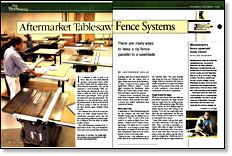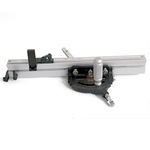Aftermarket Tablesaw Fence Systems
There are many ways to keep a rip fence parallel to a sawblade
Synopsis: Fine Woodworking’s Jefferson Kolle writes that all a tablesaw fence has to do is lock parallel to the blade. Simple function, but a complicated procedure. Kolle looked at eight “commercial” fence systems with significantly different designs. He defines the parts that compose the fence system and described things that might alter a fence assembly, such as rough or uneven saw tops. He addresses the locking controversy, and explains how he ensured a fair test. He performed a “whack” test to see how the fence held when bumped by large stock, and compared their price/warranty, locking systems, rail length, what saw sizes they fit, instruction manual quality, finish quality, rail installation difficulty, fence adjustment, vertical adjustment, and vertical squareness from the factory. An accurate fence system can eliminate a lot of fiddling; decide which features are most important to you before deciding which to buy. A side article discusses Bill Biesemeyer, maker of the first aftermarket tablesaw fence, and its many clones.
If a tablesaw is only as good as its fence, there are a lot of bad tablesaws out there. Case in point: I have a 1950sera Delta Unisaw with the original fence. With minimal maintenance, the saw has continued to work flawlessly. With constant fussing and adjusting, the fence continues to make me crazy. It works pretty well until it gets bumped. Then I get out the instructions and make adjustments. The alternative is to fuss with the fence, checking measurements at the front and back of the fence, giving it a little tap one way or the other, measure again. Arrghhh! Drives me nuts.
All a tablesaw fence has to do is lock parallel to the blade. Simple function but a complicated procedure given that the fence must lock parallel at an infinite number of distances from the blade an infinite number of times.
Since Bill Biesemeyer introduced his Tsquare fence in the 1970s, lots of manufacturers have come up with their own fences, including many that are almost identical to Biesemeyer’s. Rather than review all the Biesemeyer clones, I looked for fence systems with significantly different designs. I found eight, including the Biesemeyer. (John White, the Taunton shop steward, assembled and helped evaluate the systems.)
I chose to review “commercial” fence systems. Some companies make “home-shop” fence systems, which typically have shorter fences and smaller components than commercial systems.
This is only a test
A spokesman at Delta Manufacturing told me the company has sold more than 600,000 Unisaws since the tablesaw was introduced in 1938. To get as close as we could to an apples-to-apples fence comparison, I amassed seven Unisaws of varying vintages. The eighth saw was a General cabinet saw. In an attempt to avoid being sent ringers, we bought all of the fence systems anonymously either from the manufacturer or from a local retail outlet.
Before we start, a few definitions are in order: Rails are the metal bars that attach to the tablesaw table. The head assembly rides along the front rail. The fence is the straight metal bar attached to the head assembly along which you push wood when ripping. For the purpose of this article, and to avoid confusion, a fence system is a combination of the above components.
From Fine Woodworking #133
For the full article, download the PDF below:
Fine Woodworking Recommended Products

JessEm Mite-R Excel II Miter Gauge

Starrett 12-in. combination square

Compass






















Log in or create an account to post a comment.
Sign up Log in